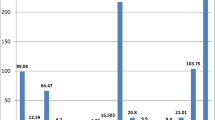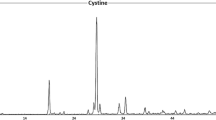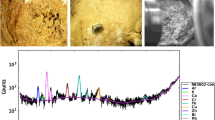Abstract
Lifestyle, food intake, and exposure to chemicals are potential risk factors for the development of calcium urolithiasis. Pb, Cd, and Hg have been proved to cause renal illness, and urinary tract stones might be caused by exposure to metals. Therefore, this study aimed to measure the concentration of metals in urinary tract stones and blood simultaneously in urolithiasis patients. Moreover, we intended to determine whether urinary tract stones can be regarded as a biomarker of exposure or an effect marker in a population with environmental exposure to metals. Thirty-five urolithiasis patients (case) and 34 healthy inhabitants (control) were recruited in this study. The contents of Pb, Cd, Cr, Cu, Ni, As, Zn, and Hg were determined in urinary stones and blood in the case and control groups. The most abundant metals were Zn and Cu in blood and Zn and Ni in urinary stones. Significantly higher levels of Zn, Ni, and As were found in calcium phosphate stones than in calcium oxalate or uric acid stones. The majority of metals were not present at consistent levels in both blood and urinary stones, except for Zn. Urinary stones might be explained as providing another metabolic pathway for metal contamination. Moreover, as the metals with the highest content in urinary stones were Ni and Zn, and Ni content was very much higher than in other countries, contamination by Ni should be further taken into consideration if there is any serious contamination in Taiwan.

Similar content being viewed by others
References
Huang WY, Chen YF, Carter S, Chang HC, Lan CF, Huang KH (2013) Epidemiology of upper urinary tract stone disease in a Taiwanese population: a nationwide, population based study. J Urol 189(6):2158–2163. https://doi.org/10.1016/j.juro.2012.12.105
Liu Y, Li S, Zeng Z, Wang J, Xie L, Li T, He Y, Qin X, Zhao J (2014) Kidney stones and cardiovascular risk: a meta-analysis of cohort studies. Am J Kidney Dis 64:402–410
Lewandowski S, Rodgers AL (2004) Idiopathic calcium oxalate urolithiasis: risk factors and conservative treatment. Clin Chim Acta 345(1-2):17–34. https://doi.org/10.1016/j.cccn.2004.03.009
Chou YH, Li CC, Wu WJ, Juan YS, Huang SP, Lee YC (2007) Urinary stone analysis of 1,000 patients in southern Taiwan. Kaohsiung J Med Science 23(2):63–66. https://doi.org/10.1016/S1607-551X(09)70376-6
Liu CC, Huang SP, Wu WJ, Chou YH, Juo SH, Tsai LY, Huang CH, Wu MT (2009) The impact of cigarette smoking, alcohol drinking and betel quid chewing on the risk of calcium urolithiasis. An Epidemiol 19(8):539–545. https://doi.org/10.1016/j.annepidem.2009.02.006
Abboud IA (2008) Mineralogy and chemistry of urinary stones: patients from North Jordan. Environm Geochem Health 30(5):445–463. https://doi.org/10.1007/s10653-007-9128-7
Thomas LDK, Elinder CG, Tiselius HG, Wolk A, Åkesson A (2013) Dietary cadmium exposure and kidney stone incidence: a population-based prospective cohort study of men & women. Environ Int 59:148–151. https://doi.org/10.1016/j.envint.2013.06.008
Jarup L, Alfven T (2004) Low level cadmium exposure, renal and bone effects-the OSCAR study. Biometals 17(5):505–509. https://doi.org/10.1023/B:BIOM.0000045729.68774.a1
Barregard L and Elinder C-G, Chapter 17 - renal effects of exposure to metals, in Handbook on the toxicology of metals (Fourth Edition), G.F.N.A.F. Nordberg, Editor. 2015, Academic Press: San Diego. p. 333–350
Karmakar R, Chatterjee M (1998) Cadmium-induced time-dependent oxidative stress in liver of mice: a correlation with kidney. Environ Toxicol Pharmacol 6(3):201–207. https://doi.org/10.1016/S1382-6689(98)00035-0
Zarasvandi A, Heidari M, Sadeghi M, Mousapoor E (2013) Major and trace element composition of urinary stones, Khuzestan province, southwest, Iran. J Geochem Explor 131:52–58
Leung SW, Siddhanti S, Williams B, Chan AWK, Minski MJ, Daniels CK, Lai JCK (2010) Effects of diet intakes on metal and electrolyte distributions in vital organs. Procedia Environ Sci 2:92–97. https://doi.org/10.1016/j.proenv.2010.10.013
Swaddiwudhipong W, Mahasakpan P, Limpatanachote P, Krintratun S (2011) An association between urinary cadmium and urinary stone disease in persons living in cadmium-contaminated villages in northwestern Thailand: a population study. Environ Res 111:579–583
Huang WY, Chen YF, Chen SC, Lee YJ, Lan CF, Huang KH (2012) Pediatric urolithiasis in Taiwan: a nationwide study, 1997-2006. Urol 79(6):1355–1359. https://doi.org/10.1016/j.urology.2012.01.036
Giannossi ML, Summa V, Mongelli G (2013) Trace element investigations in urinary stones: a preliminary pilot case in Basilicata (Southern Italy). J Trace Elem Med Biol 27:91–97
Zeng X, Xu X, Boezen HM, Huo X (2016) Children with health impairments by heavy metals in an e-waste recycling area. Chemosphere 148:408–415. https://doi.org/10.1016/j.chemosphere.2015.10.078
Singh VK, Rai AK, Rai PK, Jindal PK (2009) Cross-sectional study of kidney stones by laser-induced breakdown spectroscopy. Lasers Med Sci 24(5):749–759. https://doi.org/10.1007/s10103-008-0635-2
Keshavarzi B, Yavarashayeri N, Irani D, Moore F, Zarasvandi A, Salari M (2015) Trace elements in urinary stones: a preliminary investigation in Fars province, Iran. Environ Geochem Health 37:377–389
Ohta N (1957) Studies on inorganic constituents in biological materials—on the inorganic constituents in human stones. Bull Chem Soci Jap 30(8):833–841. https://doi.org/10.1246/bcsj.30.833
Wandt MAE, Pougnet MAB, Rodgers AL (1984) Determination of calcium, magnesium and phosphorus in human stones by inductively coupled plasma atomic-emission spectroscopy. Analyst 109(8):1071–1074. https://doi.org/10.1039/an9840901071
Joost J, Tessadri R (1987) Trace elements investigations in kidney stone patients. Eur Urol 13(4):264–270. https://doi.org/10.1159/000472792
Al-Maliki MA (1998) Renal stones a study in medical geochemistry. M. Sc. Thesis, Baghdad University, p. 101
Levinson AA, Nosal M, Davidman M, Prien ELS, Prien EL Jr, Stevenson RG (1978) Trace elements in kidney stones from three areas in the United States. Investig Urol 15(4):270–274
Chandrajith R, Wijewardana G, Dissanayake CB, Abeygunasekara A (2006) Biomineralogy of human urinary calculi (kidney stones) from some geographic regions of Sri Lanka. Environ Geochem Health 28:393–399
Kuta J, Machat J, Benova D, Cervenka R, Zeman J, Martinec P (2013) Association of minor and trace elements with mineralogical constituents of urinary stones: a hard nut to crack in existing studies of urolithiasis. Environ Geochem Health 35:511–522
Abboud IA (2008) Concentration effect of trace metals in Jordanian patients of urinary calculi. Environ Geochem Health 30(1):11–20. https://doi.org/10.1007/s10653-007-9103-3
Al-Fawaz MM (2006) Diagnostic of environmental effects in stone formation and traces on human health—northeastern of Jordan, study in medical geochemistry. M. Sc. Thesis, Al al-Bayt University. 124
Atakan IH, Kaplan M, Seren G, Aktoz T, Gül H, Inci O (2007) Serum, urinary and stone zinc, iron, magnesium and copper levels in idiopathic calcium oxalate stone patients. Int Urol Nephrol 39:351–356
Komleh K, Hada P, Pendse AK, Singh PP (1990) Zine, copper and manganese in serum, urine and stones. Int Urol Nephrol 22:113–118
Pizzorno JE, Murray MT, and Joiner-Bey H, 48 - kidney stones, in The clinician’s handbook of natural medicine (third edition). 2016, Churchill Livingstone: Edinburgh. p. 588–599
Bazin D, Chevallier P, Matzen G, Jungers P, Daudon M (2007) Heavy elements in urinary stones. Urol Res 35:179–184
Lin SM, Tseng CL, Yang MH (1987) Determination of major, minor and trace elements in urinary stones by neutron activation analysis. International Journal of Radiation Applications and Instrumentation Part A Appl Radiation Isotopes 38(8):635–639. https://doi.org/10.1016/0883-2889(87)90130-4
Tsunetada Y, Shori K, Kenichi K, Tomokazu U, Shoji K (1984) Study of urinary stone weight correlated with composition [in Japanese]. Jap J Urol 75:847–852
Perk H, Serel TA, Koşar A, Deniz N, Sayin A (2002) Analysis of the trace element contents of inner nucleus and outer crust parts of urinary calculi. Urologia Int 68(4):286–290. https://doi.org/10.1159/000058452
Słojewski M, Czerny B, Safranow K, Jakubowska K, Olszewska M, Pawlik A, Gołąb A, Droździk M, Chlubek D, Sikorski A (2010) Microelements in stones, urine, and hair of stone formers: a new key to the puzzle of lithogenesis? Bio Trace Elem Res 137(3):301–316. https://doi.org/10.1007/s12011-009-8584-6
Hofbauer J, Steffan I, Höbarth K, Vujicic G, Schwetz H, Reich G, Zechner O (1991) Trace elements and urinary stone formation: new aspects of the pathological mechanism of urinary stone formation. J Urol 145:93–96
Jhaumeer-Laulloo S, Subratty AH (1999) Analysis of urinary calculi in Mauritius. Sci Technol Res J 3:87–93
Funding
This study was supported by grants from the Council of Labor Affairs in Taiwan
Author information
Authors and Affiliations
Corresponding author
Ethics declarations
Conflict of Interest
The authors declare that they have no conflict of interest.
Rights and permissions
About this article
Cite this article
Yen, Y., Cheng, B., Chan, C. et al. Heavy Metal Components in Blood and Urinary Stones of Urolithiasis Patients. Biol Trace Elem Res 185, 266–274 (2018). https://doi.org/10.1007/s12011-018-1253-x
Received:
Accepted:
Published:
Issue Date:
DOI: https://doi.org/10.1007/s12011-018-1253-x




